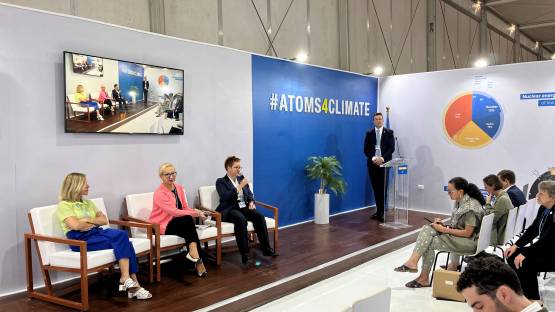Experts from the IAEA explained how nuclear science and technology can be used to help countries identify the source of greenhouse gas emissions, at an IAEA event hosted jointly with the World Meteorological Organization (WMO) at the COP27 in Egypt. Greenhouse gas emissions caused by human activities have contributed to the overall increase in global temperatures, and the event, held at the IAEA-led #Atoms4Climate pavilion, focused on the work of the IAEA and WMO supporting countries in reducing greenhouse gas emissions.
IAEA Programme Management Officer Katherina Deufrains was joined in Sharm el-Sheikh by Oksana Tarasova, Chief of the WMO Global Atmosphere Watch Programme and Celeste Saulo, Director of the National Meteorological Service of Argentina and Second Vice President of the WMO. They focused on the new initiative of the IAEA and WMO to support experts worldwide in using stable isotopes to measure the release of greenhouse gases and accurately determine their source.
Through the nuclear technique, ‘isotopic fingerprinting’, scientists can examine stable isotopes of greenhouse gases in air samples to determine their origin. “The global average temperature is not useful when it comes to decision-making. We need to know the baseline and the geographical and sectoral distributions of emissions,” said Tarasova.
Under the ground-breaking Paris Agreement in 2015, countries committed to tackling climate change at the national level by reducing their greenhouse gas emissions. In two years’ time, countries will begin reporting on their concrete progress. Understanding the source of emissions supports evidence-based policymaking and gives decision-makers the data that they need to address emissions properly and meet their reduced emission targets.
Many countries do not have the capacity to carry out the isotopic tracing of greenhouse gas emissions, and the government of Argentina, with the support of the IAEA, has agreed to host the first regional training and analysis centre on this cutting-edge technique. The training centre is being outfitted with the proper equipment and trainers are being trained in preparation for its inauguration.
“The government in Argentina has a strong commitment to implement measures to fight against climate change, and more than a commitment, we have a law that states what we are going to do to mitigate and adapt to climate change and achieve net zero by 2050. In the implementation of this law, we have included this particular project, as a concrete action,” said Saulo in her capacity as the Director of the National Meteorological Service of Argentina.
There are several benefits to regional training, in addition to the capacity building itself. It allows for the creation of a harmonized approach and the development and dissemination of standardized methods for collection and analysis, so that data can accurately be compared across countries and regions. In collaboration with the WMO, and four internationally renowned laboratories – the National Institute of Water and Atmospheric Research of New Zealand, the Swiss Federal Laboratories for Materials Science and Technology, the University of Heidelberg, and the Institute of Arctic and Alpine Research – the IAEA has drafted a good practice guide on sampling, analysis and interpretation of methane, scheduled for release next year. “The good practice document on methane is a hands-on tool for technicians and scientists around the world on sampling, analysis, and interpretation. It is very important for scientists to have one common approach to produce data that is inter-comparable,” said Deufrains.
The IAEA has been working with the WMO since 1997 to integrate nuclear techniques into climate-related projects. Building upon the success of this longstanding partnership, this new initiative aims to combine the unique expertise of the IAEA with the competency of the WMO to give countries the tools to monitor greenhouse gas emissions, thus enabling them to bolster their national efforts to meet the aims of the Paris Agreement, Kyoto Protocol and other commitments.




